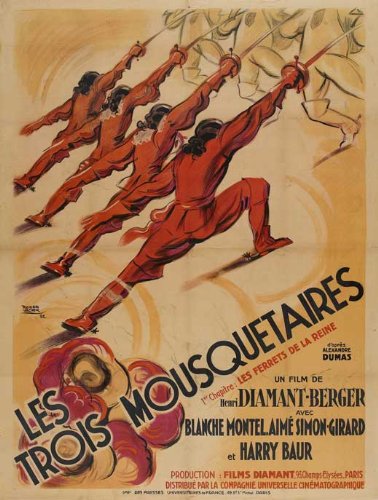Annotation:Reel des trois mousquetaires: Difference between revisions
No edit summary |
No edit summary |
||
| (2 intermediate revisions by the same user not shown) | |||
| Line 10: | Line 10: | ||
<div style="text-align:justify;"> | <div style="text-align:justify;"> | ||
{{break}} | {{break}} | ||
'''REEL DES 3 (TROIS) MOUSQUETAIRES | [[File:Musketeersfilm.jpg|500px|thumb|Film poster]] | ||
'''REEL DES 3 (TROIS) MOUSQUETAIRES''' (Three Musketeers Reel). French-Canadian, Reel (cut time). D Major. Standard tuning (fiddle). AA'BBACC'. Soucy researcher Jean Duval points out the third strain is borrowed from the tune popularly known as "[[Bonaparte Crossing the Rhine]]" (although the strain has been used for other tunes as well)<ref>Jean Duval, "La Musique de Isidore Soucy 1899-1962", 2017, p. 221. </ref>. Soucy's tune may have been inspired by the French historical adventure film directed in 1932 by Henri Diamant-Berger and starring Aimé Simon-Girard, Henri Rollan and Thomy Bourdelle. The film is an adaptation of Alexandre Dumas's '''The Three Musketeers''' (1844), and was the first version to be as a sound film. The English-language Hollywood version was filmed a few years later (1935) and starred Walter Abel (as the callow youth d'Artagnan), Heather Angel (as Constance), Ian Keith, Margot Grahame, and Paul Lukas. | |||
{{break|2}} | {{break|2}} | ||
</div> | </div> | ||
Latest revision as of 16:23, 28 December 2019
X:1 T:Reel des trois mousquetaires T:Three Musketeers' Reel M:C| L:1/8 R:Reel N:Play AA'BBACC' N:from the playing of Isidore Soucy (1899-1963, Montreal, Québec) D:Starr 16088A (78 RPM), Isidore Soucy (1937) F:http://www.collectionscanada.ca/obj/m2/f7/13928.mp3 Z:Transcribed by Andrew Kuntz K:D d2|S"*"adfa dfdf |A2DD =CDEC| DFAd cece|[M:3/2]fdef e2 ee e2e2| fdfa dfdf|A2DD =CDEC|DFAd cece|1d2f2d2:|2d2f2d2d2|| |:"**"Ad d2 ceec|dfdf e2gg|(3fgf ed ceBe|AAGA FAEA|edcB AGFE| DDFA d>ddd|[M:3/2]ceec dfff e>ggg|[M:C|]fgfd efec|dedc d2d2:| |:FG|AFBF AFAd|fgfe dcdB|AFAc BAFD|EFED EFGB| AFBF AFAd|fgfe dcdB|[M:3/2]AFAc BBEB cccc |1[M:C|]d>ddd d2:|2d>ddd d2fgS|| P:Substitutions: "*"a/f/dfa dfdf||"**"addd ceec|dfff eggg|

REEL DES 3 (TROIS) MOUSQUETAIRES (Three Musketeers Reel). French-Canadian, Reel (cut time). D Major. Standard tuning (fiddle). AA'BBACC'. Soucy researcher Jean Duval points out the third strain is borrowed from the tune popularly known as "Bonaparte Crossing the Rhine" (although the strain has been used for other tunes as well)[1]. Soucy's tune may have been inspired by the French historical adventure film directed in 1932 by Henri Diamant-Berger and starring Aimé Simon-Girard, Henri Rollan and Thomy Bourdelle. The film is an adaptation of Alexandre Dumas's The Three Musketeers (1844), and was the first version to be as a sound film. The English-language Hollywood version was filmed a few years later (1935) and starred Walter Abel (as the callow youth d'Artagnan), Heather Angel (as Constance), Ian Keith, Margot Grahame, and Paul Lukas.
- ↑ Jean Duval, "La Musique de Isidore Soucy 1899-1962", 2017, p. 221.
